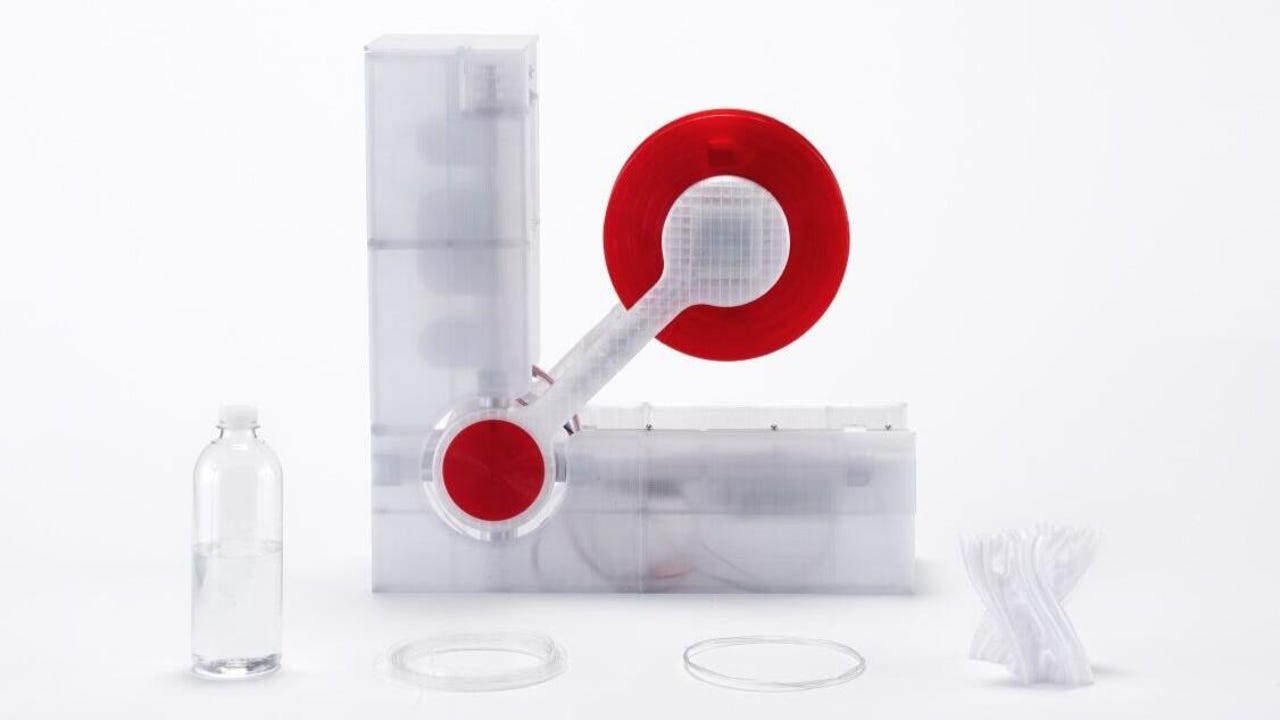
































Here's a prototype of the Polyformer.
Image: Reiten ChengPlastics, ecologically speaking, have gotten a pretty bad reputation over the years, often quite deservedly so.
If you're in the market for a 3D printer, you'll find one here that fits your needs.
Read nowNonprofit ocean conservation organization Oceana reports that two garbage trucks worth of plastic enters the world's oceans every minute. That's 33 billion pounds of plastic entering oceans every year. Mapping service Arcgis has charting data that shows there are five major patches of plastic-covered ocean covering 20 million square kilometers (7.72 million square miles). That's enough plastic to blanket Alaska, Texas, California, Montana, and New Mexico (The United States' five largest states by area).
The US Environmental Protection Agency reports that the US generated 35.7 million tons (roughly the weight of 17.8 million Tesla Model 3 vehicles) worth of plastic. Overall, only 8.7% of the plastic produced is recycled, but that rate differs based on the type of plastic because different types of plastics have very different chemical properties.
PLA, or polylactic acid, is the most common type of plastic used in 3D printing. It's a very easy-to-use material, it adheres to the print bed well, and is reasonably robust for many uses. It deteriorates in the sun and can be brittle, but the vast majority of items I've made have been printed with PLA because it works well in extrusion 3D printers.
PLA has some pluses ecologically, as well. Rather than being made from fossil fuels, it's made from renewable resources like corn, cassava, sugarcane or sugar beet pulp. PLA is also biodegradable, although there are some definite footnotes to that claim. It doesn't compost well. About half of the material decays over time, but the rest can remain for hundreds or even thousands of years. You don't want to dump PLA in landfills for the same reason. But PLA does incinerate rather nicely, leaving no residue or toxic fumes.
When it comes to recycling, PET (or polyethylene terephthalate), is something of a winner. According to the EPA, nearly 30% of all PET has been recycled. This is hugely important because PET is the material used to make plastic water bottles and jars. According to the University of Southern Indiana, Americans use 2.5 million plastic bottles every hour, most of which are thrown away after use.
A modified variant of PET, known as PETG (polyethylene terephthalate glycol-modified), is also quite popular in 3D printing. PETG replaces the ethylene glycol in PET with cyclohexanedimethanol, which adds six additional carbon atoms. This makes the molecular structure less tight, and that allows the plastic to melt at a lower temperature.
PETG will melt at about 230 degrees C. By contrast, PET (the water bottle plastic) will melt, but at temperatures closer to 280 degrees C. That's near the top end of the temperature range for most hobby-level extruders on 3D printers.
The fact that PET can technically be 3D printed opens up a simple question: How can we turn water bottle plastic into 3D printable filament?
Reiten Cheng, an industrial designer who just graduated this spring from Pasadena's ArtCenter College of Design, seems to have an answer. And it's open source. He calls it the Polyformer.
Polyformer heated extrusion mechanism
Image: Reiten ChengThe idea for the Polyformer is simple. Use a pair of scissors to cut the bottom off of a water bottle. Insert the bottle in the Polyformer. The device slices the bottle into strips. An extruder heats the strips and pushes out plastic filament. From used bottle to ready-to-use filament, it's an idea with potential.
While filament does come in larger and smaller amounts, most filament is sold on 1 kilogram spools. When I spoke to Cheng on his Polyformer Discord channel, he told me that roughly 33 bottles would create a kilogram spool of filament.
I see this as a great community or makerspace project. A school or makerspace could collect the bottles and turn them into filament spools.
3D printed parts and additional components that make up the Polyformer
Image: Reiten ChengAs I mentioned above, PET is a bit of a challenge to 3D print, especially with how stringy it gets and how difficult it is to dial in the temperature settings. But once that's figured out, a school or makerspace could have a virtually infinite (and free) supply of this very robust 3D printing material.
Slicing mechanism
I was particularly curious about how the bottles are cut. Discord user @Alextrical told me that, "It's the bearings that cut the bottle, the edges slide over each other and shear the plastic similar to scissors." So this would be safe in a community environment, and there are no issues involved in sharpening or replacing blades.
It should be noted that Cheng isn't the first to build a PET plastic bottle to filament recycling device. He cites as inspiration Joshua Taylor at recreator3d.com, which has plans and parts lists for a similar device. Taylor's approach is to convert a Creality Ender 3 3D printer into a "Plastic Bottle Pultrusion Unit".
It's an interesting approach -- upcycling a 3D printer to make a device that recycles plastic bottles to be used as filament for a 3D printer.
So what about you? Do you think you'll build a device like this? Do you want to do your part in recycling plastic bottles by turning them into 3D printing filament? Let us know in the comments below.
You can follow my day-to-day project updates on social media. Be sure to follow me on Twitter at @DavidGewirtz, on Facebook at Facebook.com/DavidGewirtz, on Instagram at Instagram.com/DavidGewirtz, and on YouTube at YouTube.com/DavidGewirtzTV.
 Hot Tags :
Tech
Makers
Hot Tags :
Tech
Makers